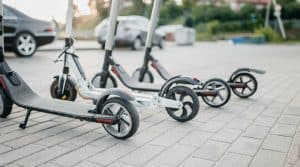The Dangerous (In)convenience of Dockless Scooters and Bikes
 Life used to be so much simpler – and safer – before everything became electronic. Life is now so fast paced that rules and basic courtesy have flown right out the window. Now, drivers fail to use turn signals or obey basic traffic laws, often while fiddling with their radio or GPS. Shoppers ignore moving traffic and traipse through parking lots as if they’re casually sightseeing while texting or talking on their cell phones. Somewhat recently, electronic scooters and bikes were added to the mix offering just one more dangerous problem to contend with.
Life used to be so much simpler – and safer – before everything became electronic. Life is now so fast paced that rules and basic courtesy have flown right out the window. Now, drivers fail to use turn signals or obey basic traffic laws, often while fiddling with their radio or GPS. Shoppers ignore moving traffic and traipse through parking lots as if they’re casually sightseeing while texting or talking on their cell phones. Somewhat recently, electronic scooters and bikes were added to the mix offering just one more dangerous problem to contend with.
Taking some of the human factor out with the addition of technology was supposed to help make our lives easier. Instead, we’ve allowed it to take over thinking for us and that’s leading to more people being hospitalized for personal injuries, including head injuries. E-bikes and e-scooters were born out of the idea that traveling in congested cities has become a time-consuming hassle at a time when everyone wants convenience. These vehicles are capped at traveling a whopping 15 miles per hour and riders are encouraged to wear helmets and avoid pedestrians just as they would with any motorcycle or bicycle. Unfortunately, the safety guidance provided and lack of regulation is still not enough to prevent catastrophes from occurring.
Be prepared for severe injuries due to a variety of risks
The damage that can be inflicted to a person – rider or pedestrian – when traveling at 15 miles per hour is the equivalent to an impact of falling off a ladder from a height of 7.5 feet. Think about how you might be hurt after falling from nearly one-story. Those involved in an accident related to an e-scooter or e-bike, have experienced:
- Broken bones 84% of victims
- Serious head injuries, including traumatic brain injury 50% of victims
- Twisted limbs 45% of victims
- Bleeding 5% of victims
- Organ damage 1% of victims
Should your bike or scooter have an encounter with a larger vehicle like a car, you risk the same injuries, but with a harder impact can come more devastating internal injuries.
Parking the scooters has become a “public nuisance” in some cities that have taken it as far as banning the vehicles, or fining companies for each vehicle improperly parked. Because they’re no longer utilizing kiosks for pick up and drop off, the bikes are left at the doorstep of the rider’s destination. Sometimes the bike is literally left at the doorstep, but frequently they’re abandoned anywhere the rider suddenly chooses to disembark the vehicle.
Leaving e-bikes and e-scooters scattered poses a danger of becoming injured to passersby. If a bike or scooter is laid down in the middle of a sidewalk, it’s a tripping hazard. Bikes left too close to the curb can be knocked over by opening a car door. There was an instance caught on camera of a man throwing his e-bike onto the tracks at a train terminal. That action could have had consequences that nobody predicted, ranging from damage to the train to injuries to passengers waiting on the platform.
E-bike and E-scooter injuries and deaths are underreported
That we currently know of, since September 2018, there have been at least 16 people around the country who have died from using e-scooters alone. One of those victims died in Washington, D.C. If the number of deaths doesn’t grab your attention, the number of injuries riding these vehicles might.
Over 1,500 injuries were reportedly treated in 2018 at only 23 hospitals around the country that provided data. Consider for a moment that there are over 4,800 community hospitals in the country. With more bikes and scooters hitting the streets in more cities this past year, significant increases in injuries and deaths should be expected.
The bottom line is that dockless e-scooters and e-bikes are unsafe for everyone and the small amount of inconvenience you are saving yourself may not be worth the potential lifetime of inconvenience you will endure if you become seriously injured.

For more than 40 years, Barry J. Nace has worked to protect the rights of victims of medical malpractice and other personal injuries. Throughout his career, he has proven that multimillion-dollar awards are not a matter of luck, but the result of experience, hard work, outstanding trial skills, and an unquestioned dedication to justice. To date, Mr. Nace has produced dozens of verdicts and settlements in excess of $1 million with three in excess of $30 million. Read more about Barry J. Nace.
